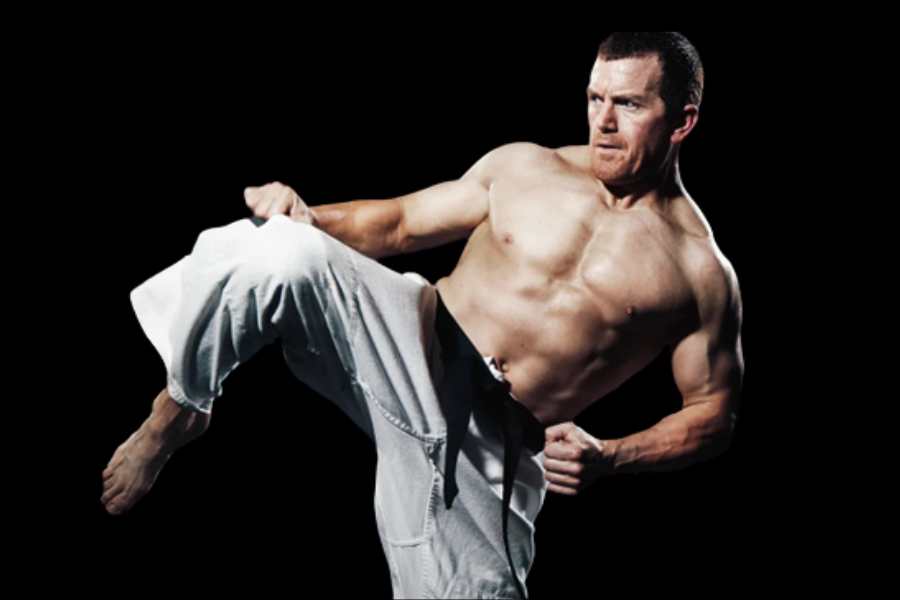This post gives you seven cardio karate workouts that you can use to improve your heart health, endurance, and overall fitness and potentially burn off some extra calories to lose unwanted fat.
Karate-Inspired Cardio Workouts and Their Benefits
Cardio, also known as aerobic exercise, is any activity that raises your heart rate and increases oxygen and blood circulation in your body.
Examples of traditional cardio exercises are swimming, running, rope-jumping, cycling, dancing, or competitive sports.
However, nowadays, many cardio workouts have been created based on martial art movements taken from karate, taekwondo, Muay Thai, or kickboxing.
While the traditional forms of cardio like running, swimming, or rowing still work, relying solely on them for a long period of time can lead to a plateau – your body will get used to the same movements that are repeatedly performed over time.
Mixing and matching with martial art based cardio workouts can challenge your body and take your fitness to the next level.
If you are a karateka, performing these exercises while visualizing elements of combat can also help with your karate and fighting skills in general.
If you want to use cardio to lose weight, switching exercises regularly and giving your body new challenges all the time can also help you avoid plateau and burn off more calories.
For example, if you never run, you will burn a lot of calories when you first take up running. But if you keep running, the number of calories you burn per same running session will decline gradually over time. This is because humans and other animals appear to have the ability to adapt to increased physical activities and are able to conserve energy very effectively.
But if you switch to a new activity after a couple of months of running, your body will face a new kind of challenge and the amount of energy burned will again increase initially.
Below are seven cardio karate workouts that you can try out at home.
Cardio Karate Workout
1. Double knee strike workout
Double knee strike is a very effective cardio karate exercise that helps you to lose weight, improve your balance, and helps you to build lean muscles. It is an incredible workout for your abdominal muscles, back, and arms.
Advantages of double knee strike workout
This workout helps in burning fat by increasing your metabolism rate. In addition, it also improves your endurance and strength levels.
You can perform this workout in any place at any time.
How to perform
In order to perform this technique, put your hands out in front of you, paralleling to the floor with palms facing down. Now try to strike both palms with your knees. You can imagine striking someone’s groin or chest area while doing the technique.
Aim for one technique per second and keep going for one minute. Get half a minute’s rest and then repeat.
If you are new to this technique, please build it up gradually. You could begin by placing your hand a bit lower (at around 45-degree angle) and do just around 20 and then add more reps as you feel more comfortable.
If you have a knee injury, please wait until you have fully recovered.
2. Push /Jump Kick Combo workout
The Push/Jump Kick combo is one of the incredible ways to get a full-body workout. It combines two of the most common martial arts moves that involve the push kick and the jump kick.
This exercise works on your glutes, core, quads, and hamstrings, so it’s great for improving your leg strength and also can help in reducing lower back pain.
How to perform
Stand straight with feet shoulder-width apart. Raise your knees while keeping your back in a straight position, then perform the push kick with the right leg and immediately perform a jump kick with the left leg after that.
You can perform 20 sets of push + jump kicks and have a 60-second rest before repeating.
3. Front Kick/Punch Combination
The front kick and straight punch are essential part of many karate styles and are often performed as part of kata practice.
Performing this combo in a low stance is an excellent way to get your heart rate up while working your core and leg muscles.
How to perform
To perform this combination workout, stand in kiba dachi (horse stance). Try to keep your stance low with your back straight.
Perform a front kick (mae geri) and then immediately perform an oi tsuki (same side as the kicking leg) after the kicking leg has landed. Repeat with the other leg and arm.
Perform 20 sets as fast and powerfully as you can.
While this might look simple at first glance, the fact that you have to stand in kiba dachi stance will make it very challenging for some people. However, at the same time, it can be a very effective exercise to build up lower body strength.
4. Continuous Punch
If you train in karate, there is a good chance that you have come across this exercise before.
All you do is punch continuously for one minute as fast and as hard as you can.
You can do just kizami tsuki or combine it with other punches like gyaku tsuki, kage tsuki and mawashi tsuki. Always imagining attacking an opponent with these punches.
Rest for one minute and then repeat.
You should aim for 10 to 15 minutes of punching (i.e. 20 to 30 minutes in total) for each training session.
It’d be great if you perform this exercise on heavy bags or pads with a partner. If that is not possible, it is still a great cardio exercise even if you do it at home without bags or pads.
This is a very simple but effective cardio workout that can also help you improve your punching techniques. If you pay attention to using your hips and core muscles, you will definitely improve your punching power.
5. Continuous Kicks
Even if you don’t like to use your kicking techniques in actual sparring, this kicking exercise will help improve your endurance, lower muscle strength, and flexibility.
You will do five different kicks continuously: kin geri, mae geri, mawashi geri, yoko geri, and ushiro geri.
You will be alternating between the left and right legs and moving forward while doing the kicks. Keep going until you run out of space. You can then turn around and repeat.
You should be able to do this for 10 – 15 minutes without any issues. But like all other exercises, please build it up gradually depending on your fitness level.
If you enjoy exercises #4 and #5, alternate them. For example, aim for one day doing continuous punches and the next day doing continuous kicks. This will give the muscles some time to rest and recover in between the exercises.
6. Timed Sparring
This is a great exercise for someone who is into kata or kumite competitions. It is not only a great workout but also a necessary preparation for your competitions.
Set the timer for three minutes and perform whatever combos you like during the three minutes, whether they are blocks and counter-attacks or feigning techniques and counter-attacks.
Rest for one minute then repeat.
You should aim for around ten rounds of three minutes of non-stop sparring. Although you won’t do that many rounds in a competition, pushing your body beyond what is required will significantly improve your endurance as well as your mental toughness.
But if you are generally unfit or only start karate, maybe begin with just one or two rounds and stop when you feel you need to.
If you could do this with an actually sparring partner, that would be great, but you certainly can do it by yourself a few times a week and still get huge benefits from the exercise.
7. Kata challenge
A kata challenge can be as challenging as you would like. It is a great way for karate practitioners to practice their techniques while building up their endurance.
Because of the wide variety of techniques contained in kata, you will certainly have a full-body workout that is guaranteed to be a lot more fun than the circuits that you may do at the gym.
You can also do this anytime and anywhere with no equipment and even with very limited space.
You can set a 10 minutes, 30-minute, or one-hour kata challenge depending on your fitness level.
What you do in this time period is perform all the kata you know with full speed, power and martial intent. That is performing all techniques as fast and as powerfully as you can while visualizing a fight with an opponent.
If you only know one or two kata, repeat these katas again and again until you reach your time target.
If you know the bunkai for the kata, you can perform the kata and then the bunkai as well.
You can also set 100 kata, 200 kata or 1000 kata as a challenge.
For example, if you want to do a 100 kata challenge, you perform any kata you like (repeat one, two, or ten kata that you know) until you’ve done 100 kata altogether.
Born Tough
This post has been contributed by Born Tough, a California-based company that specializes in selling high-quality modern sportswear. Their products are designed to look great and feel comfortable, whether you’re hitting the gym for the hardest workout session ever or going for a casual coffee stroll.
Although we are not affiliated with or sponsored by Born Tough in any way, we love their quality products. If you’re looking for new workout gear, we highly recommend checking them out.


